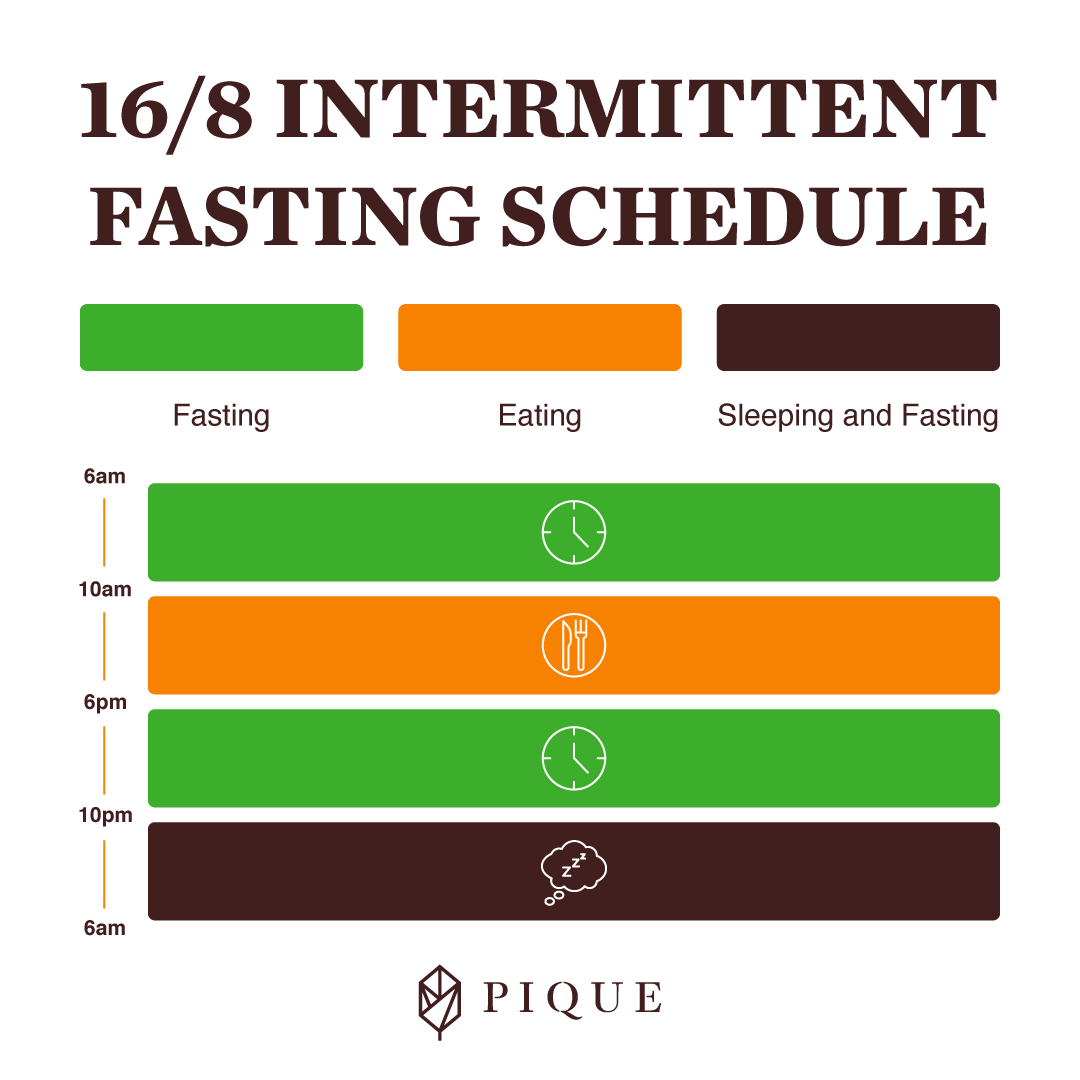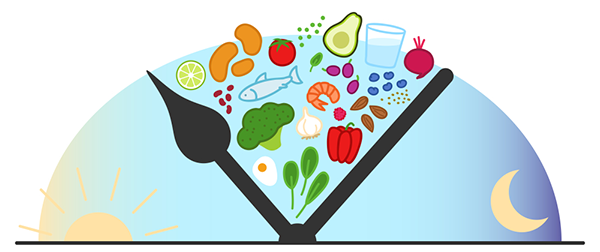What’s the difference between intermittent fasting vs. time restricted eating?
Even though the basics of intermittent fasting (IF) and time restricted eating (TRE) may sound similar, IF and TRE aren’t identical.
And one may be a better fit for your lifestyle and health goals than the other.
So in this guide, you’ll learn everything you need to know to decide which is right for you, including what IF and TRE have in common and where they differ.
To begin, let’s explore intermittent fasting since most people are more familiar with this style of scheduled eating.
What is Intermittent Fasting?
If you’re a regular reader of our blog, you may have already seen our guides on intermittent fasting, the benefits of IF, and different IF schedules.
Since we covered those topics extensively in those guides, we’ll only offer a brief refresher to get everyone up to speed here:
Basically, the principle behind intermittent fasting is simple: each 24-hour day is split into two segments: one period of time for eating and one for fasting.
A typical IF schedule and the most popular is called the 16/8 plan. Here, you’ll fast for 16 straight hours and only eat during an 8-hour window of time during your day.

An 8-hour eating window means you can nosh from 11am to 7pm, or 12pm to 8pm, or any other block of time that fits your schedule and hunger needs.
This ability to adjust the feeding or eating window allows you to either decrease or increase your fasting based on how you feel and your own personal health markers.
Some people enjoy following the 16/8 IF schedule for days while others may only practice it one to four times per week.
Another popular form of IF is known as the 5:2 diet.
Unlike the 16/8 plan where you alternate between fasting and feeding cycles in one day, the 5:2 plan calls for you to alternate fasting days.
As the ratio suggests, you’ll eat normally for five days. But two days each week, women will reduce their daily calories by 500 and men will cut 600 calories from their diet to mimic a small fast.
According to one study, obese participants lost anywhere from 3% to 8% of their body weight in as little as eight weeks by eating this way (1).
You can learn more about the different types of IF in this guide to fasting schedules. Check it out when you’re done reading this one.
The reason so many people are trying IF is because of all the incredible health benefits it offers.
5 Science-Backed Benefits of Intermittent Fasting
As we mentioned in this Beginner’s Guide, you’ll score the following perks with intermittent fasting no matter which style you follow:
- Healthy weight management. During your fasting periods, you’ll give your body the “thumbs up” to use your fat stores for energy, which can help unlock your body’s natural weight management mechanisms.
- Supported energy levels. When your body taps into its own energy stores during your fasted states, you’ll avoid the rollercoaster of ups and downs that happens when you eat every 2-3 hours.
- Greater focus and mental clarity. Intermittent fasting gives your brain the boost it needs by supporting levels of your brain-derived neurotrophic factor, or BDNF, which is associated with brain connectivity and creating new neurons.
- Supported cognitive function. Intermittent fasting also supports neurological health, including memory and overall brain function.
- Support for healthy blood sugar levels. By giving your body a rest and not feeding it calories during your fasted state, you’re allowing it to use up its own glucose supply. This means less excess blood sugar is left floating around your system.
With all those awesome health benefits, you may be wondering if IF is something you should try. We’ll help you answer that question next.
Is Intermittent Fasting Right For You?
Intermittent fasting can be a helpful tool if you’re interested in any of the above potential health benefits.
However, this style of eating may not be right for you if you’re:
- Diabetic
- Hypoglycemic
- Struggling with blood sugar regulation issues
- Pregnant
- Breastfeeding
- Recovering from a history of disordered eating
Now that you have the basics of IF under your belt, let’s dive into everything you need to know about time-restricted eating to compare.
What is Time Restricted Eating?
Time-restricted eating is a form of intermittent fasting.
Just like with IF, there are two periods in your day: an eating window and a fasting window.
However, unlike IF, on TRE the focus shifts to how many hours per day you get to eat vs. how long you have to fast.
So you may start out with a 12-hour eating window, such as eating from sunrise to sunset, or between 7am and 7pm, or 8am to 8pm. Then you’ll fast all times outside of that designated window.
Eventually you’ll start to cut down your eating window to 10, eight, or even just six hours per day and naturally find yourself fasting longer.

This method is super helpful if you’re someone who likes to graze for snacks late at night. You can nip this bad habit in the bud and prevent unintentional weight gain by setting an endpoint for your eating and sticking to it.
Since your body will have plenty of time to digest your dinner before bed, you’ll spend less time processing and storing calories and more time in quality rest when you’re sleeping.
On top of that, many people find it easier to think about when to eat versus when not to eat, or when they need to fast.
So this simple shift in focus between TRE and IF may fit better with your schedule and eating preferences.
Knowing this, the next question to answer is:
Is Time-Restricted Eating Right For You?
People who stick to TRE tend to:
- Prefer eating breakfast as opposed to skipping it on IF
- Find it impossible to go an entire day without food
- Work better with flexible times they can eat vs. absolute times they must fast
Unfortunately, there aren’t as many published studies on time restricted eating yet.
But there is good news:
The research we do have shows there are plenty of reasons to try this way of eating, just like the other styles of IF.
3 Proven Benefits of Time Restricted Eating
Here are the top advantages of TRE that have been studied so far:
- Support healthy weight management. One study discovered obese participants were able to reduce their body weight and calorie intake over a 12-week period when they used an 8-hour feeding window (2). Another body of research found that study participants who were considered overweight but healthy could reduce their weight and keep it off for a year after the study when they used a 10-hr TRE window (2).
- Lower body mass while keeping lean mass intact. When studying young men who took part in resistance training, researchers gave these athletes feeding windows between 4–8 hours long, which naturally reduced their calorie intake without them having to count calories. They also learned the men successfully decreased body fat without losing their lean muscle mass (2).
- Improved sleep and energy. Researchers in a different study discovered that using a 10–11-hour eating window led to better sleep, improved energy levels, and supported weight management in participants (3).
One reason for the better sleep is that TRE puts your body in sync with its natural circadian rhythm. That allows your body to sleep when it needs to instead of breaking down energy from food just before bed.

So as you can see, both IF and TRE offer advantages for your health. But how will you know which is right for you?
How to Decide Between the Differences between IF vs. TRE
To decide between IF and TRE, answer these questions:
Is it easier for you to remember when to eat or when to fast? Intermittent fasting focuses on how long you’ll go without food; TRE focuses on the times you plan to eat.
When are you most hungry? If you’re not craving breakfast when you first wake up, IF may be easy for you. But if you’re normally starved after your AM workout, TRE may be a better schedule for refueling.
Similarly, if you find yourself hungry most often at night, TRE will either break this habit or you’ll be allowed to eat later on IF and burn off those calories during your fast the next morning.
Do you like keeping track of what you eat? While many forms of IF don’t require you to count calories, following a 5:2 plan means you’ll need to track what you eat so you can cut calories appropriately during fasting days. A TRE plan would not require you to do this.

Do you have certain medical conditions or restrictions? IF should not be used if you’re pregnant, breastfeeding, diabetic, hypoglycemic, or dealing with other health issues. TRE does not have the same restrictions.
Now that you know more about the similarities and differences between intermittent fasting and time-restricted eating, you’re probably wondering how to get started.
Where to Go From Here: Intermittent Fasting vs. Time-Restricted Eating and You
Before you embark on an intermittent fasting schedule or time-restricted eating plan, you should first get clearance from your doctor to make sure you don’t have any acute illnesses or medical conditions lurking undiagnosed.
Once you have the green light from your doctor, start slowly. Whether you choose to focus on how long you’ll fast (IF) or the set times you’ll eat (TRE), remember to ease into it little by little.
If you start out with a 12-hour eating window, gradually taper that amount by 30 minutes to one hour as you get used to fasting longer. Then you may cut this down to 10 or eight hours of eating until you reach a balance that’s ideal for you.
As the research shows, both IF and TRE offer fantastic health benefits for your body so they may be worth trying at least once.
If this is your first time trying intermittent fasting, check out our beginner’s guide on IF which covers everything you need to know to get started!






